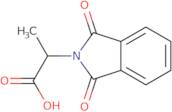Phthalyl-DL-alanine
CAS: 19506-87-7
Ref. 3D-FP164129
| 5g | Descontinuado | ||
| 10g | Descontinuado | ||
| 25g | Descontinuado | ||
| 50g | Descontinuado | ||
| 100g | Descontinuado |
Informação sobre produto
- 1,3-Dihydro-1,3-dioxo-α-methyl-2H-isoindole-2-acetic acid
- 1,3-Dihydro-α-methyl-1,3-dioxo-2H-isoindole-2-acetic acid
- 2-(1,3-Dihydro-1,3-dioxo-2H-isoindol-2-yl)propanoic acid
- 2-(1,3-Dioxo-2,3-dihydro-1H-isoindol-2-yl)propanoic acid
- 2-(1,3-Dioxoisoindolin-2-yl)propanoic acid
- 2-Isoindolineacetic acid, α-methyl-1,3-dioxo-
- 2-Phthalimidopropanoic acid
- 2-Phthalimidopropionic acid
- 243-117-4
- 2H-Isoindole-2-acetic acid, 1,3-dihydro-α-methyl-1,3-dioxo-
- Ver mais sinónimos
- <span class="text-smallcaps">D</smallcap><smallcap>L</span>-N-Phthaloylalanine
- Alanine, N-phthaloyl-
- N-Phthaloyl-<span class="text-smallcaps">DL</span>-alanine
- N-Phthalyl-<span class="text-smallcaps">DL</span>-alanine
- NSC 13404
- 2-(1,3-Dioxo-1,3-dihydro-2H-isoindol-2-yl)propanoic acid
Phthalyl-DL-alanine is a molecule that has been immobilized onto activated carbon and then activated with chloroformate. It is soluble in water and hydrochloric acid, but insoluble in organic solvents. The reaction vessel used to activate the molecule is a glass tube that contains a stopper, a plug, and a condenser. This process is done by adding hydrochloric acid to the reaction vessel. The chemical reactions are catalyzed by enzymes that are found in cells. Activated Phthalyl-DL-alanine inhibits tumour cell proliferation by blocking chloride channels on the surface of cancer cells, which prevents the entry of chloride ions into the cell. This causes an imbalance of ions inside the cell and leads to death of the cancerous cells.





